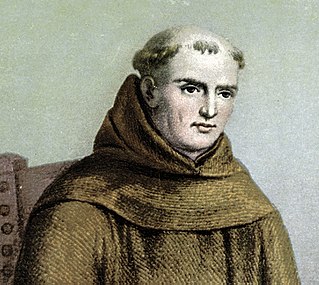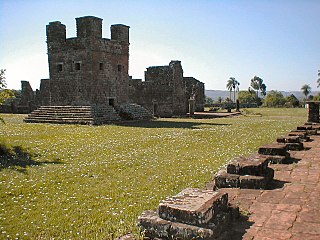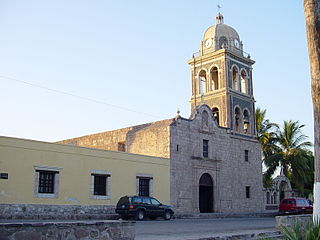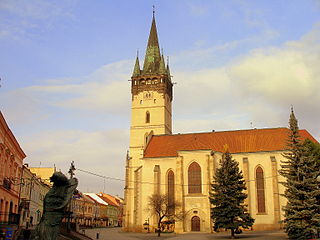
Saint Junípero Serra y Ferrer, popularly known simply as Junipero Serra, was a Spanish Catholic priest and missionary of the Franciscan Order. He is credited with establishing the Franciscan Missions in the Sierra Gorda, a UNESCO World Heritage Site. He founded a mission in Baja California and established eight of the 21 Spanish missions in California from San Diego to San Francisco, in what was then Spanish-occupied Alta California in the Province of Las Californias, New Spain.

The Jesuit missions among the Guaraní were a type of settlement for the Guaraní people in an area straddling the borders of present-day Argentina, Brazil and Paraguay. The missions were established by the Jesuit Order of the Catholic Church early in the 17th century and ended in the late 18th century after the expulsion of the Jesuit order from the Americas. The missions have been called an experiment in "socialist theocracy" or a rare example of "benign colonialism". Others have argued that "the Jesuits took away the Indians' freedom, forced them to radically change their lifestyle, physically abused them, and subjected them to disease".

The suppression of the Society of Jesus was the removal of all members of the Jesuits from most of Western Europe and their respective colonies beginning in 1759 along with the abolition of the order by the Holy See in 1773. The Jesuits were serially expelled from the Portuguese Empire (1759), France (1764), the Two Sicilies, Malta, Parma, the Spanish Empire (1767) and Austria, and Hungary (1782). Political manoeuvrings both in Rome and within each country involved influenced this timeline. The papacy reluctantly acceded to the anti-Jesuit demands of various Catholic kingdoms while providing minimal theological justification for the suppressions.

Francisco Hermenegildo Tomás GarcésO.F.M. was a Spanish Franciscan friar who served as a missionary and explorer in the colonial Viceroyalty of New Spain. He explored much of the southwestern region of North America, including present day Sonora and Baja California in Mexico, and the U.S. states of Arizona and California. He was killed along with his companion friars during an uprising by the Native American population, and they have been declared martyrs for the faith by the Catholic Church. The cause for his canonization was opened by the Church.

The Mainasmissions refers to a large number of small missions the Jesuits established in the western Amazon region of South America from 1638 until 1767, when the Jesuits were expelled from Latin America. Following the Jesuit expulsion, mission activity continued under Franciscan auspices.

La Santísima Trinidad de Paraná, or the Most Holy Trinity of Paraná, is the name of a former Jesuit reduction in Paraguay. It is an example of one of the many Jesuit reductions, small colonies established by the missionaries in various locations in South America, such as Brazil, Argentina and Paraguay throughout the 17th and 18th century. These missions were built as self-contained societies that existed outside of regular Spanish colonial life that integrated indigenous populations with Christian faith.

Mission Santa Rosalía de Mulegé is located in the oasis of Mulegé, in Mulegé Municipality, northeastern Baja California Sur state, México. It is an Instituto Nacional de Antropología e Historia listed Cultural Heritage Monument.

The Spanish missions in Mexico are a series of religious outposts established by Spanish Catholic Franciscans, Jesuits, Augustinians, and Dominicans to spread the Christian doctrine among the local natives. Since 1493, the Kingdom of Spain had maintained a number of missions throughout Nueva España in order to preach the gospel to these lands. In 1533, at the request of Hernán Cortés, Carlos V sent the first Franciscan friars with orders to establish a series of installations throughout the country.

Beginning in the 16th century Spain established missions throughout New Spain in order to facilitate colonization of these lands.

The Spanish Missions in New Mexico were a series of religious outposts in the Province of Santa Fe de Nuevo México — present day New Mexico. They were established by Franciscan friars under charter from the monarchs of the Spanish Empire and the government of the Viceroyalty of New Spain in a policy called Reductions to facilitate the conversion of Native Americans into Christianity.

Misión de Nuestra Señora de Loreto Conchó, or Mission Loreto, was founded on October 25, 1697, at the Monqui Native American (Indian) settlement of Conchó in the city of Loreto, Baja California Sur, Mexico. Established by the Catholic Church's Jesuit missionary Juan María de Salvatierra, Loreto was the first successful mission and Spanish town in Baja California.

The Spanish missions in Baja California were a large number of religious outposts established by Catholic religious orders, the Jesuits, the Franciscans and the Dominicans, between 1683 and 1834. The missionary goal was to spread the Christian doctrine among the Indigenous peoples living on the Baja California peninsula. The missions gave Spain a valuable toehold in the frontier land, and would also act as a deterrent to prevent pirates from using the peninsula of Las Californias as a jumping off point for contraband trade with mainland New Spain. Missionaries introduced European livestock, fruits, vegetables, and industry into the region. Indigenous peoples were severely impacted by the introduction of European diseases such as smallpox and measles; furthermore, the expulsion of the Jesuits from the Spanish Empire in 1767 ripped the social fabric of the peninsula, although Franciscans were sent to replace them. In 1769, the Franciscans moved to Upper California, leaving Dominicans in charge of Baja California. By 1800 indigenous numbers were a fraction of what they had been before the arrival of the Spanish, yet even today many people living in Baja California are of indigenous heritage.

The Catholic Church during the Age of Discovery inaugurated a major effort to spread Christianity in the New World and to convert the indigenous peoples of the Americas and other indigenous peoples. The evangelical effort was a major part of, and a justification for, the military conquests of European powers such as Portugal, Spain, and France. Christian missions to the indigenous peoples ran hand-in-hand with the colonial efforts of Catholic nations. In the Americas and other colonies in Asia, and Africa, most missions were run by religious orders such as the Franciscans, Dominicans, Augustinians, and Jesuits. In Mexico, the early systematic evangelization by mendicants came to be known as the "Spiritual Conquest of Mexico".
Missionary work of the Catholic Church has often been undertaken outside the geographically defined parishes and dioceses by religious orders who have people and material resources to spare, and some of which specialized in missions. Eventually, parishes and dioceses would be organized worldwide, often after an intermediate phase as an apostolic prefecture or apostolic vicariate. Catholic mission has predominantly been carried out by the Latin Church in practice.

Jesuit missions in North America were attempted in the late 16th century, established early in the 17th century, faltered at the beginning of the 18th, disappeared during the suppression of the Society of Jesus around 1763, and returned around 1830 after the restoration of the Society. The missions were established as part of the colonial drive of France and Spain during the period, the "saving of souls" being an accompaniment of the constitution of Nouvelle-France and early New Spain. The efforts of the Jesuits in North America were paralleled by their China missions on the other side of the world, and in South America. They left written documentation of their efforts, in the form of The Jesuit Relations.

In 16th-century Christianity, Protestantism came to the forefront and marked a significant change in the Christian world.

The Catholic Church in Latin America began with the Spanish colonization of the Americas and continues up to the present day.

The Spanish missions in the Americas were Catholic missions established by the Spanish Empire during the 16th to 19th centuries in the period of the Spanish colonization of the Americas. Many hundreds of missions, durable and ephemeral, created by numerous Catholic religious orders were scattered throughout the entirety of the Spanish colonies, which extended southward from the United States and Mexico to Argentina and Chile.